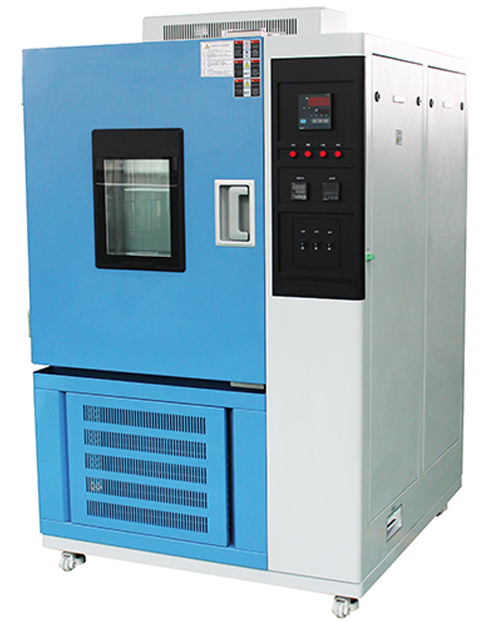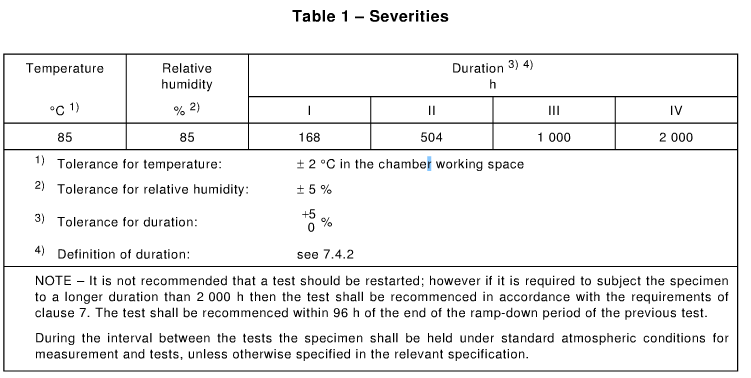Environmental Test Chambers for IEC 60068-2-67 Damp heat, steady state, accelerated test primarily intended for components
This international standard provides a standard test procedure for the purpose of evaluating, in an accelerated manner, the resistance of small electrotechnical products, primarily non-hermetically sealed components, to the deteriorative effect of damp heat. In this test the specimen is subjected to very high levels of unsaturated damp heat for a relatively long period. Then a environmental test chamber is necessary.
The test provides a number of preferred durations at a relative humidity of 85% and a temperature of 85℃. In the case of plastic encapsulated components degradation results from absorption of water-vapour by the plastic and penetration of moisture along terminals.
The chamber shall be constructed that:
a. It can produce the temperature and relatively humidity given in table 1 for a minimum period of 2000h without interruption;
b. It is capable of providing controlled conditions of temperature and relatively humidity during testing, and the ramp-up and ramp-down from specified test conditions;
c. The temperature and humidity of the chamber can be monitored by means of sensing devices located in the working space and/or other areas giving the same results;
d. Any water shall be continuously drained from the working space and not re-used.
e. Condensed water is not allowed to fall on the specimen.
f. The materials used in the construction shall not cause any significant corrosion of the specimen, or degradation of the quality of the humidifying water.

The specified humidity tolerance will be exceeded if such temperature differences exceed 1.5℃. It is also necessary to restrict the short-term temperature fluctuations due to cycling of the chamber heater to a similar value. The specimen should not significantly impede the air flow. Condensation shall not be allowed to form on the specimen at any time during the test.
Distilled or deionised water shall be used. The water shall have a resistivity of not less than 0.5 MΩcm at 23℃. The PH value shall be between 6.0 and 7.2 at 23℃. Before the water is placed in the humidifier, all internal parts of the chamber shall be cleaned. Guidance on cleaning is given in clause B.3.
The humidifier and/or test chamber shall be purged of all water after each test.
The test severity, defined by the duration, shall be defined in the relevant specification. Unless otherwise specified, one of the durations given in table 1 shall be used.

With the chamber and specimen at the laboratory conditions of temperature, pressure and humidity, the specimen shall be installed in the working space in the chamber. The specimen shall not be subjected to radiant heat from the heaters or the chamber wall.
If required by the relevant specification, a specific mounting structure shall be used. The heat conductivity and the thermal capacity of the mounting fixtures shall be sufficiently low so that for all practical purposes the specimen is thermally isolated. Care shall be exercised in the choice of mounting structure and mounting fixture materials to minimise the effects of contamination and to minimise degradation due to corrosion and other mechanism.
If required by the relevant specification the specimen shall have a bias voltage applied during testing. Guidance on the application of bias is given as belows:
Bias voltage is defined as that voltage which is applied for test purposes in order to enchance the effects of humidity. It is not necessarily concerned with the normal functioning of the specimen. The bias should be applied in accordance with the following guidelines, which are given in order of decreasing importance:
a. The temperature increase of defined locations within and at the surface of the specimen should be less than 2℃ with respect to the nominal temperature of the working space.
b. Care should be exercised when choosing the voltage to both promote hydrolysis and to limit self-heating of the specimen, since this will affect the penetration and/or absorption of moisture. Where it is not possible to prevent significant self-heating with continuous bias applied, it is recommended that the bias should be applied intermittently. Unless otherwise specified, the periods should be 3h off followed by 1h on. The sequence should commence with the bias off.
c. Precautions should be taken to limit energy dissipation due to faulty conditions.
The bias voltage ( or bias voltage cycle) shall be applied to the specimen when the temperature and the relative humidity have reached the stable state and continue until the specimen is under recovery conditions.
The temperature and relative humidity of the chamber shall be raised to their appropriate values. During this period the temperature and the relative humidity shall not exceed the specified value. Condensed water is not allowed on the specimen at any time during the test cycle. Stabilization of temperature and humidity shall take place within 3h.
The temperature and relative humidity shall be maintained within the prescribed limits for a duration as specified in the relevant specification. The duration shall commence as soon as the conditions have stabilised.
At the end of the specified duration, the chamber temperature and relative humidity shall be restored to standard atmospheric conditions for measurements and tests in not less than 1h and not more than 4h. During this period, the temperature and the relative humidity shall not exceed the specified value. The bias shall be maintained during this period.
From the article, we can see:
Temperature: 85℃
Humidity: 85% Duration: 168/504/1000/2000h
Tolerance for temperature: ±2℃
Tolerance for humidity: ±5%
To reach those specified data, a programmable temperature and humidity test chamber is needed.
For more details, please feel free to contact sales@lenpure.com
Please visit www.lenpure.com.











